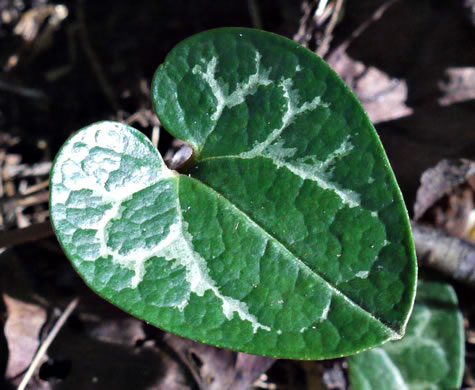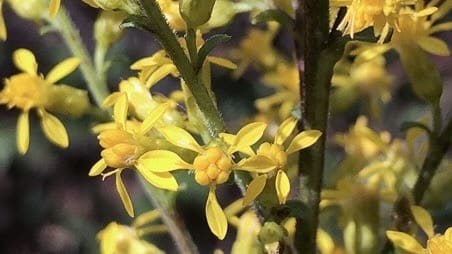A SCNPS RIGHT PLANT RIGHT PLACE GUIDE NATIVE GROUND COVERS FOR SHADE GARDENS
Finding the right plant for shady areas in our yards can be challenging, so we’ve put together a short-list of those we recommend for our South Carolina gardeners. This is not an exhaustive list, just some of our favorites in no particular order that were selected for their characteristics and are easy to grow. Many of these are available at our bi-annual chapter plant sales or you can check with some of the nurseries on our South Carolina Native Plant Nurseries list.
We encourage you to use this as a starting place, and when you find one you think is a good match, visit one of our favorite resources below for further reading on the characteristics.
- Missouri Botanical Garden Plant Finder
- North Carlina State University Plant Database
- Mt Cuba Center Plant Finder
LEGEND:
Type: F= Fern, G=Grasses, HP=Herbacious Perennial, S=Shrub, T=Tree, V=Vine
Zone: USGS Plant Hardiness Zones
Sun: Fsu=Full Sun, Psu=Part Sun, Psh=Part Shade, Fsh=Full Shade, PMsh=Late Afternoon Shade
Moist: Dry=Messic or dry, Med=Average (1″/week), Moist=Consistently Moist (do not dry out), WD=Well Drained Soil, DT=Drought Tolerant
Spread (method(s) of spreading): Root nodes, Rhizomes, Re-Seeding
Benefits: Deer/Y=Deer Tolerant, Erode/Y=Erosion Prevention, Wild=Attracts Wildlife, Host=Insect Host Plant
Propagate: Cut=Cuttings (root &/or stem), Div=Root Division, Seed=Sexual Reproduction by re-seeding/pollination
Partridgeberry (Mitchella repens)
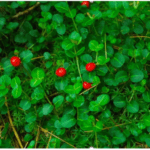 A trailing, evergreen perennial herb, noted for its dark foliage, mid-summer fragrant white flowers and red berries beloved by birds in fall and winter. No taller than 2 in. high this woodland creeper with highly ornamental foliage makes an excellent groundcover, particularly under acid-loving shrubs and trees in humus-rich soil with sand or grit. Somewhat slow to establish, it thrives in full sun to part shade with average moisture (after establishing). Technically a vine but does not climb. Companion plants include spring ephemerals like Pink Lady Slipper, Bloodroot, Mayapple, Trilliums and Black Cohosh. Deer and small animals also eat the berries. (Photo by Joshua Mayer)
A trailing, evergreen perennial herb, noted for its dark foliage, mid-summer fragrant white flowers and red berries beloved by birds in fall and winter. No taller than 2 in. high this woodland creeper with highly ornamental foliage makes an excellent groundcover, particularly under acid-loving shrubs and trees in humus-rich soil with sand or grit. Somewhat slow to establish, it thrives in full sun to part shade with average moisture (after establishing). Technically a vine but does not climb. Companion plants include spring ephemerals like Pink Lady Slipper, Bloodroot, Mayapple, Trilliums and Black Cohosh. Deer and small animals also eat the berries. (Photo by Joshua Mayer)
Robin’s Plantain (Erigeron pulchellus)
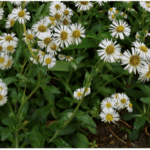 A rapidly colonizing plant, the April – June pale violet bloom and interesting leaf makes for a pleasant meadow-like groundcover spring untill fall then dies back to a rosette of basal leaves for the winter months. Usually deer resistant, they thrive in poor soil, so do not fertilize. Rapid growth by stolon in full to part sun and will tolerate part shade. A robust re-seeder. It’s drought tolerant once established, and also a good choice for rock gardens, as it fills in space quickly. (Photo by Cathy DeWitt)
A rapidly colonizing plant, the April – June pale violet bloom and interesting leaf makes for a pleasant meadow-like groundcover spring untill fall then dies back to a rosette of basal leaves for the winter months. Usually deer resistant, they thrive in poor soil, so do not fertilize. Rapid growth by stolon in full to part sun and will tolerate part shade. A robust re-seeder. It’s drought tolerant once established, and also a good choice for rock gardens, as it fills in space quickly. (Photo by Cathy DeWitt)
White-Wood Aster (Eurybia divaricata)
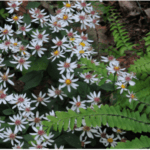 This resilient favorite is a must-have for fall gardens. A perennial groundcover preferring neutral to slightly acidic soils in shady woodland margins in the Upstate. A vigorous self-seeder, it also spreads by rhizomes, and matures to 2-3 ft tall and wide in about 3 years. It’s fairly drought-tolerant and low maintenance once established and is a favorite of wildlife. Pairs well with Cinnamon fern, Blue-stemmed Goldenrod, Solomon Seal, Foamflower and Wild Ginger. Unpalatable to deer and nontoxic to domestic animals. (Photo courtesy of Mt. Cuba Center)
This resilient favorite is a must-have for fall gardens. A perennial groundcover preferring neutral to slightly acidic soils in shady woodland margins in the Upstate. A vigorous self-seeder, it also spreads by rhizomes, and matures to 2-3 ft tall and wide in about 3 years. It’s fairly drought-tolerant and low maintenance once established and is a favorite of wildlife. Pairs well with Cinnamon fern, Blue-stemmed Goldenrod, Solomon Seal, Foamflower and Wild Ginger. Unpalatable to deer and nontoxic to domestic animals. (Photo courtesy of Mt. Cuba Center)
Lyre leaf Sage (Salvia lyrata)
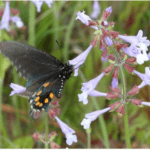 If you’re looking for some color options, this native perennial provides beautiful dark purple crowns with flowering stalks April to June. In winter, the plant dies back to its basal stem but remains visible. Growing 1-2 ft tall and spaced 9-12” it can be used as a groundcover, border plant, or even a mowable turf alternate, and makes an interesting contrast when alternated with other plants. Full sun to part shade, well-drained medium to wet moisture and it’s not picky about soils. Unlike ferns and many other groundcovers, it attracts both bees and butterflies. It’s tolerant of heat and humidity as well, and both drought and flood tolerance once established. It spreads by self-seeding and will colonize well in optimal conditions. (Photo by John Flannery)
If you’re looking for some color options, this native perennial provides beautiful dark purple crowns with flowering stalks April to June. In winter, the plant dies back to its basal stem but remains visible. Growing 1-2 ft tall and spaced 9-12” it can be used as a groundcover, border plant, or even a mowable turf alternate, and makes an interesting contrast when alternated with other plants. Full sun to part shade, well-drained medium to wet moisture and it’s not picky about soils. Unlike ferns and many other groundcovers, it attracts both bees and butterflies. It’s tolerant of heat and humidity as well, and both drought and flood tolerance once established. It spreads by self-seeding and will colonize well in optimal conditions. (Photo by John Flannery)
3 Leaf Stonecrop (Sedum ternatum)
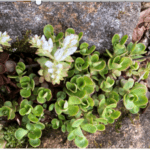 Technically a succulent, this plant stores it own water, spreads by creeping stems which root at the nodes. The stems die-back in winter, but the roots survive then separated from the host plant. Vigorous but not invasive, Stonecrop is a drought resistant, easy-care perennial groundcover or rock garden plant with few problems. It prefers shady, well-drained, moist locations but will take more sun if moisture is available. Companion plants include Quaker Ladies, Red Columbine, Dwarf Crested Iris, Fire Pink and Green & Gold. (Photo by Patty Felder)
Technically a succulent, this plant stores it own water, spreads by creeping stems which root at the nodes. The stems die-back in winter, but the roots survive then separated from the host plant. Vigorous but not invasive, Stonecrop is a drought resistant, easy-care perennial groundcover or rock garden plant with few problems. It prefers shady, well-drained, moist locations but will take more sun if moisture is available. Companion plants include Quaker Ladies, Red Columbine, Dwarf Crested Iris, Fire Pink and Green & Gold. (Photo by Patty Felder)
Green & Gold (Chrysogonum virginianum)
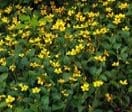 This deer-resistant semi-evergreen favorite is a low-growing perennial forming a low 1-2” mat. Sow these plants in average soil about 18” apart. It can grow in full shade (deep woodland) semi-shade (light woodland) with moisture requirement increasing to the degree of sun exposure. Keep consistently moist but well-drained the first year to establish then average moisture. It grows fast by stolon and re-seeding. The yellow flower blooms are robust from mid-spring to mid-summer, and reblooms again in the fall. Pair with spring ephemerals like Lady Slippers, Foamflower and Plantain Lily. (Photo by Tom Potterfield)
This deer-resistant semi-evergreen favorite is a low-growing perennial forming a low 1-2” mat. Sow these plants in average soil about 18” apart. It can grow in full shade (deep woodland) semi-shade (light woodland) with moisture requirement increasing to the degree of sun exposure. Keep consistently moist but well-drained the first year to establish then average moisture. It grows fast by stolon and re-seeding. The yellow flower blooms are robust from mid-spring to mid-summer, and reblooms again in the fall. Pair with spring ephemerals like Lady Slippers, Foamflower and Plantain Lily. (Photo by Tom Potterfield)
Wild Ginger (Asarum canadense)
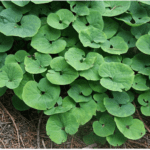 This low-growing herbaceous perennial is deciduous and dies back in winter, but makes for an interesting ground cover for part to full shade areas and is deer tolerant. The unique leaf shape adds textural contrast makes for a stunning groundcover. It spreads slowly by rhizomes in acidic well-drained soils that maintain continuous moisture, and is beneficial for erosion control. Although not related to culinary ginger, the roots do have a similar scent. Slugs and snails can occasionally be a problem. Use for shady woodland gardens or rain gardens. (Photo by Michael Wolf)
This low-growing herbaceous perennial is deciduous and dies back in winter, but makes for an interesting ground cover for part to full shade areas and is deer tolerant. The unique leaf shape adds textural contrast makes for a stunning groundcover. It spreads slowly by rhizomes in acidic well-drained soils that maintain continuous moisture, and is beneficial for erosion control. Although not related to culinary ginger, the roots do have a similar scent. Slugs and snails can occasionally be a problem. Use for shady woodland gardens or rain gardens. (Photo by Michael Wolf)
Large flower Heartleaf (Hexastylis shuttleworthii)
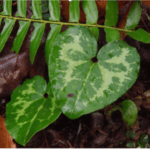 Although very similar to the more common Wild Ginger above, this plant is endemic only to a half-dozen southeastern states and is grown for its attractive 2-4” heart-shaped leaves that vary from dark green to mottled green with pale silver veins. It spreads slowly, preferring part to full shade with average moisture. Ideally situated under evergreen plants in acidic, well drained soils with good organic matter, The late-spring blooming maroon flowers are interesting and attractive and lie on the ground often hidden beneath the leaves. Grows well with native spring ephemerals. (Photo by Janie Marlow from NameThatPlant.net)
Although very similar to the more common Wild Ginger above, this plant is endemic only to a half-dozen southeastern states and is grown for its attractive 2-4” heart-shaped leaves that vary from dark green to mottled green with pale silver veins. It spreads slowly, preferring part to full shade with average moisture. Ideally situated under evergreen plants in acidic, well drained soils with good organic matter, The late-spring blooming maroon flowers are interesting and attractive and lie on the ground often hidden beneath the leaves. Grows well with native spring ephemerals. (Photo by Janie Marlow from NameThatPlant.net)
Another similar SC native is Little Brown Jug Hexastylis arifolia, which thrives in part to full shade in medium moisture.
Allegheny Spurge (Pachysandra procumbens)
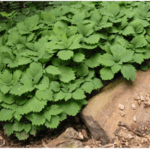 This native ‘Pachysandra’ is the right choice over the Japanese version which can be invasive in SC. A reliable evergreen once established, it’s an excellent choice for shade groundcover, favoring neutral to slightly acidic well-drained soils rich with organics (compost). Space 9” apart and drip irrigate the first year to establish, and they should grow together forming a beautiful weed-blocking ground-cover by the 2nd or 3rd season. This plant spreads by rhizomes and is easy to propagate by division. Blooming in early spring with white fragrant flowers. (Photo by Jim Robbins)
This native ‘Pachysandra’ is the right choice over the Japanese version which can be invasive in SC. A reliable evergreen once established, it’s an excellent choice for shade groundcover, favoring neutral to slightly acidic well-drained soils rich with organics (compost). Space 9” apart and drip irrigate the first year to establish, and they should grow together forming a beautiful weed-blocking ground-cover by the 2nd or 3rd season. This plant spreads by rhizomes and is easy to propagate by division. Blooming in early spring with white fragrant flowers. (Photo by Jim Robbins)
Golden Ragwort (Packera aurea)
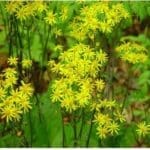 An easily grown semi-evergreen perennial bringing bright spring colors, then forming an effective groundcover in shady, moist to dry woodlands, but has a low drought tolerance. The plants form colonies spreading readily by seed and underground roots. You can remove the woody stems before or after seed fall, depending on your preference for re-seeding. Ideal for woodland garden or a shady perennial border and complemented by White Wood Aster, Solomon Seal, Wood Fern, and Eastern Blue Star. It’s the host plant for the Cinnabar Moth and provides pollen. (Photo courtesy Mt. Cuba Center)
An easily grown semi-evergreen perennial bringing bright spring colors, then forming an effective groundcover in shady, moist to dry woodlands, but has a low drought tolerance. The plants form colonies spreading readily by seed and underground roots. You can remove the woody stems before or after seed fall, depending on your preference for re-seeding. Ideal for woodland garden or a shady perennial border and complemented by White Wood Aster, Solomon Seal, Wood Fern, and Eastern Blue Star. It’s the host plant for the Cinnabar Moth and provides pollen. (Photo courtesy Mt. Cuba Center)
Creeping Phlox (Phlox stolonifera)
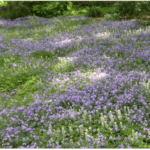 These dainty and fragrant lavender flowers attract both moths and butterflies (especially Swallowtails) from July to September. The semi-evergreen foliage spreads by rhizomes and forms dense colonies in slightly acidic and rich organic soils under part to full shade with consistent moisture. In full sun additional moisture may be required. They pair well with a variety of our spring ephemerals on stalks that grow easily through the thick mat and will have come and gone prior to their own blooming. (Photo by David J.Stang)
These dainty and fragrant lavender flowers attract both moths and butterflies (especially Swallowtails) from July to September. The semi-evergreen foliage spreads by rhizomes and forms dense colonies in slightly acidic and rich organic soils under part to full shade with consistent moisture. In full sun additional moisture may be required. They pair well with a variety of our spring ephemerals on stalks that grow easily through the thick mat and will have come and gone prior to their own blooming. (Photo by David J.Stang)
Dwarf crested iris (Iris cristata)
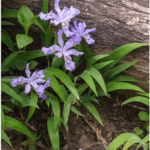 These lovely lavender to purple blooms on low-growing plants buzz with activity from bees and hummingbirds early spring (April in the Upstate). Vigorously self-naturalizing, the deer resistant foliage spreads quickly in part to full shade over time in organically rich and well-drained soils with medium moisture. The blooming may be somewhat reserved in full shade and in full sun they’ll require adequate moisture. (Photo by Janie Marlow from NameThatPlant.net)
These lovely lavender to purple blooms on low-growing plants buzz with activity from bees and hummingbirds early spring (April in the Upstate). Vigorously self-naturalizing, the deer resistant foliage spreads quickly in part to full shade over time in organically rich and well-drained soils with medium moisture. The blooming may be somewhat reserved in full shade and in full sun they’ll require adequate moisture. (Photo by Janie Marlow from NameThatPlant.net)
Foamflower (Tiarella cordifolia)
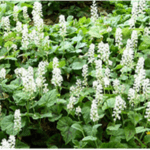 May is a bit late for some spring ephemerals but if you hike along the slopes of our cove forests in the Upstate in May. There you’re likely to find drifts of white and pinkish flowers blooming in the part to full shade in the rich loam soils under the tree canopy. It’s a bit finicky in that it’s intolerant of drought in summer and too much wetness in winter, but if you can avoid those, it makes a great ground cover. Self-naturalizing by stolen, this plant forms large colonies over time (Photo by Sue Dingwell of the Virginia NPS)
May is a bit late for some spring ephemerals but if you hike along the slopes of our cove forests in the Upstate in May. There you’re likely to find drifts of white and pinkish flowers blooming in the part to full shade in the rich loam soils under the tree canopy. It’s a bit finicky in that it’s intolerant of drought in summer and too much wetness in winter, but if you can avoid those, it makes a great ground cover. Self-naturalizing by stolen, this plant forms large colonies over time (Photo by Sue Dingwell of the Virginia NPS)
Native Vines
South Carolina has a number of native vines, some of which also make excellent ground covers for shady areas. Read “SCNPS Top 10 Native Vines” for more information.
Turf Grass Alternatives
If you’re looking to return some of your turf grass lawn to a more wildlife friendly habitat, read “Native Alternatives to Turfgrass Lawns.”
Native Sedges
There are a number of Sedges (Carex) that work well as border and ground covers in light to full shade and medium to wet conditions. See the article “Native Sedges for Shade Gardens” for more information.
Native Ferns
South Carolina has a great selection of native ferns that make excellent ground covers for shady areas. See “SCNPS Native Ferns for Shade Gardens” for more information.

